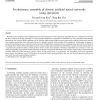TNN
2010
13 years 10 months ago
2010
In this paper, we present the evolution of adaptive resonance theory (ART) neural network architectures (classifiers) using a multiobjective optimization approach. In particular, w...
APIN
2004
14 years 3 months ago
2004
This paper describes the result of our study on neural learning to solve the classification problems in which data is unbalanced and noisy. We conducted the study on three differen...
IJON
2008
14 years 3 months ago
2008
Recently, many researchers have designed neural network architectures with evolutionary algorithms but most of them have used only the fittest solution of the last generation. To ...
FLAIRS
2000
14 years 4 months ago
2000
In this note we present and discuss results of experiments comparing the performance of six neural network architectures (back propagation, recurrent network with dampened feedbac...
ICONIP
2007
14 years 4 months ago
2007
There is no consensus on measuring distances between two different neural network architectures. Two folds of methods are used for that purpose: Structural and behavioral distance ...
CEC
2008
IEEE
14 years 5 months ago
2008
IEEE
Abstract-- Genetic algorithms have been used to evolve several neural network architectures. In a previous effort, we introduced the evolution of three well known ART architects; F...
ICANN
2009
Springer
14 years 7 months ago
2009
Springer
Learning to solve small instances of a problem should help in solving large instances. Unfortunately, most neural network architectures do not exhibit this form of scalability. Our...


